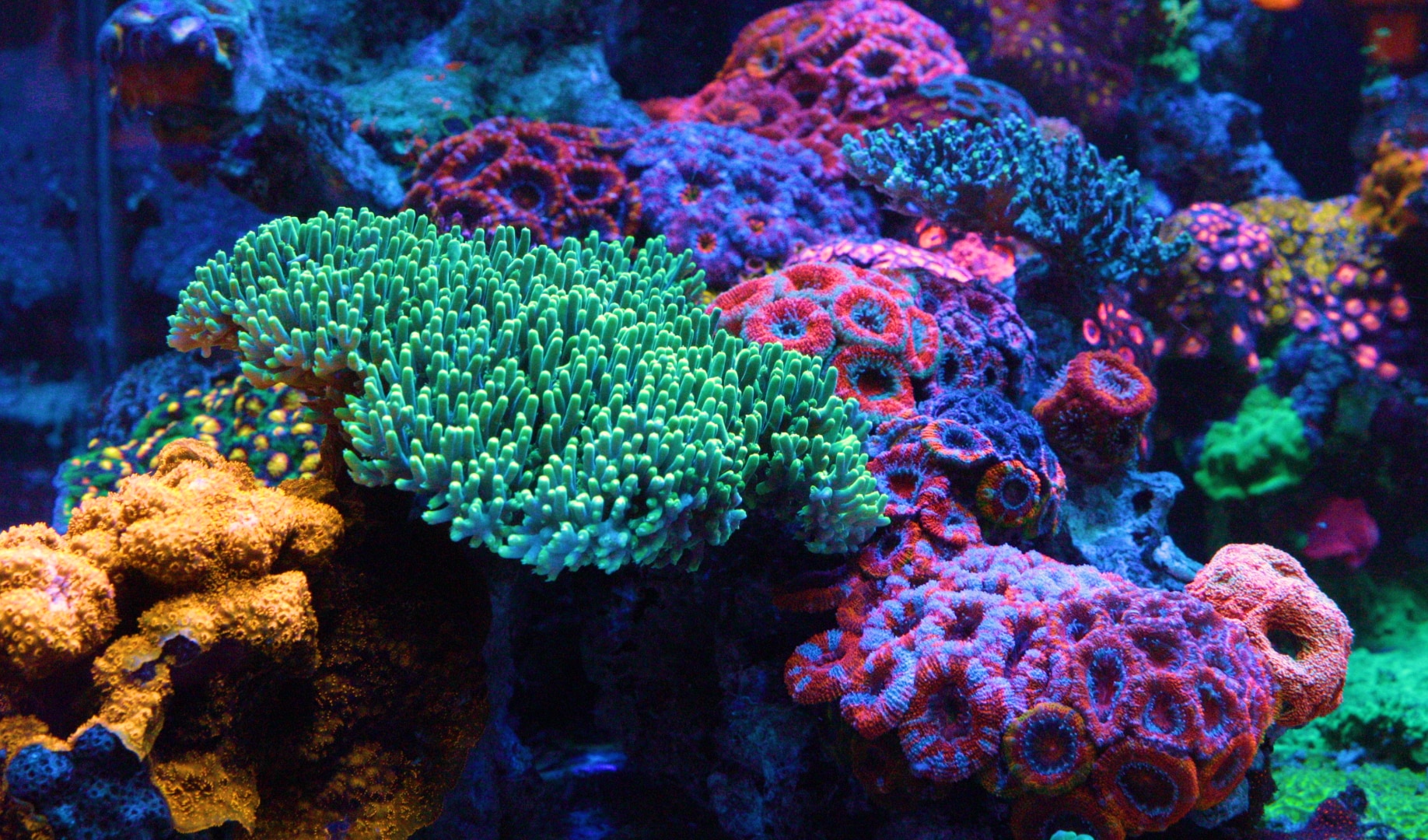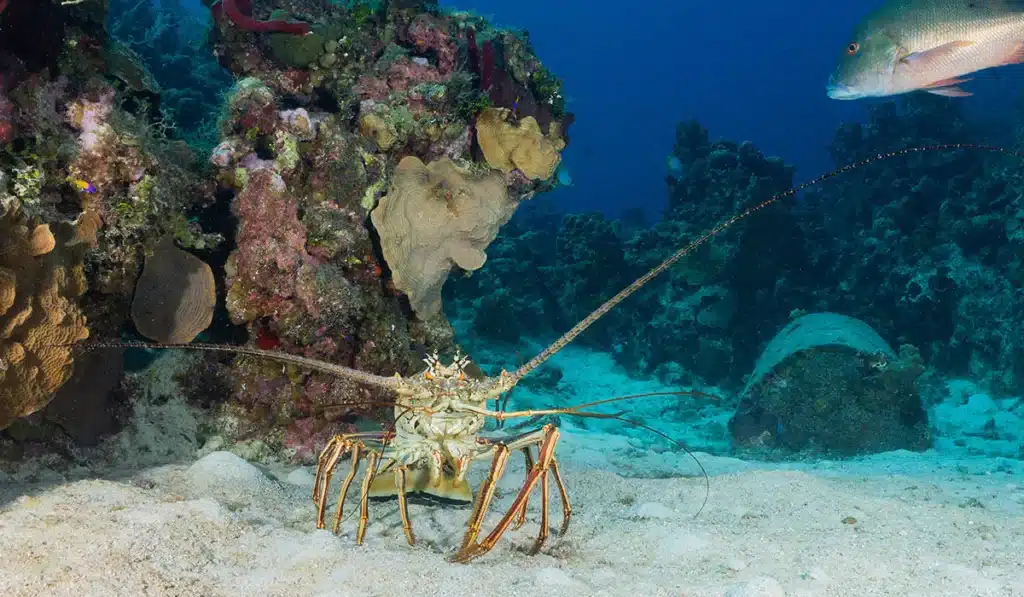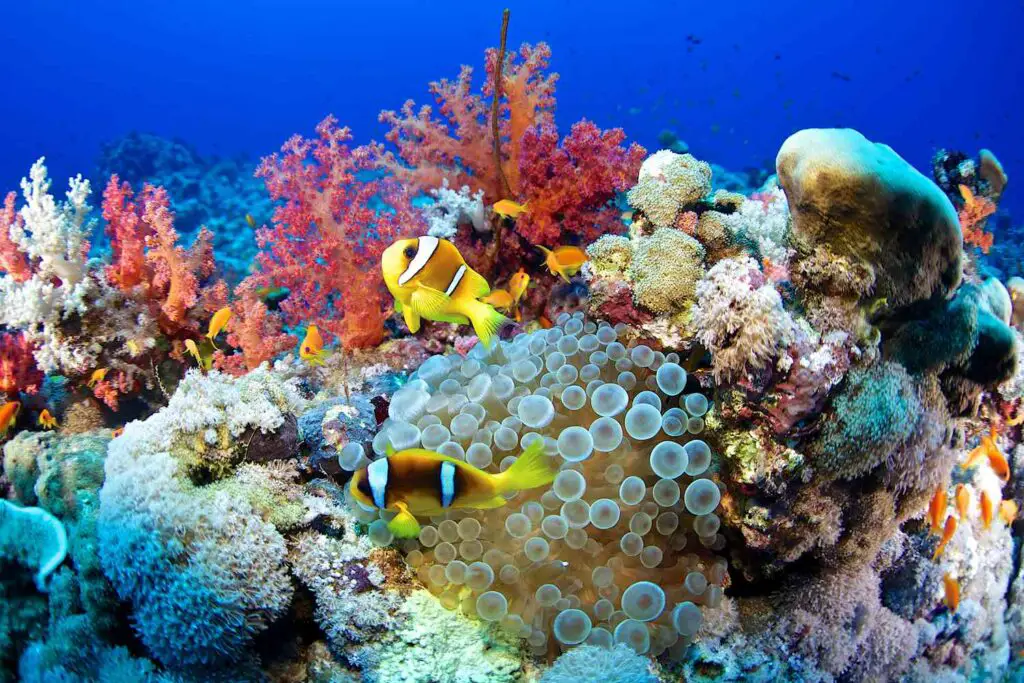What Organisms Live In Coral Reefs

Introduction
What Organisms Live In Coral Reefs: Coral reefs, often referred to as the “rainforests of the sea,” are some of the most biodiverse ecosystems on our planet. These vibrant underwater communities are characterized by their intricate structures built primarily by tiny, colonial organisms called coral polyps. While corals play a crucial role in reef formation, the real allure of coral reefs lies in the astounding variety of organisms that call them home.
Beneath the crystal-clear waters of tropical oceans, coral reefs offer a mesmerizing world where an astonishing array of life thrives. Coral polyps themselves are fascinating creatures, resembling small, translucent sea anemones. These remarkable organisms form massive colonies and create calcium carbonate skeletons, which serve as the foundation for the entire reef ecosystem.
Coral reefs are not solitary habitats; they are bustling cities of marine life. Fish of all sizes, from the diminutive clownfish to the majestic humphead wrasse, find shelter and sustenance among the coral branches. Invertebrates like sea stars, sea urchins, and sea cucumbers contribute to the reef’s diversity, while crustaceans like colorful shrimp and crabs hide within its crevices.
Coral reefs are also home to an incredible assortment of mollusks, including snails, clams, and nudibranchs, each displaying remarkable adaptations to their environment. Moreover, larger predators like sharks and turtles patrol the reef’s perimeters, completing this intricate and delicately balanced ecosystem.

How many organisms live in coral reefs?
Often nicknamed the “rainforests of the sea,” coral reefs are some of the most diverse ecosystems on Earth. Scientists believe that more than a million species around the world live on coral reefs.
Coral reefs are bustling underwater ecosystems teeming with a remarkable diversity of life. It is estimated that coral reefs support over 25% of all marine species, despite covering less than 1% of the ocean floor. This extraordinary biodiversity is one of the key reasons coral reefs are often referred to as the “rainforests of the sea.”
While it is challenging to pinpoint an exact number, scientists estimate that there could be hundreds of thousands of different organisms living in coral reefs. These organisms encompass a wide range of life forms, including corals, fish, crustaceans, mollusks, sponges, and countless microorganisms. Coral reefs serve as vital habitats, providing shelter, breeding grounds, and food sources for this vast array of marine life.
Coral reefs are not only home to an immense number of species but also play a crucial role in supporting the livelihoods of millions of people through fisheries, tourism, and coastal protection. Sadly, these remarkable ecosystems are under threat from climate change, ocean acidification, pollution, and overfishing.
What is the living organism in coral?
Corals consist of small, colonial, plankton-eating invertebrate animals called polyps, which are anemone-like. Although corals are mistaken for non-living things, they are live animals.
Coral reefs are intricate ecosystems teeming with life, and at the heart of these vibrant underwater communities are tiny living organisms known as coral polyps. Coral polyps are the building blocks of coral reefs, and they belong to the phylum Cnidaria, which includes sea anemones and jellyfish.
These remarkable creatures are minuscule, often less than a centimeter in size, and they possess a cylindrical body with a mouth surrounded by tentacles armed with stinging cells called cnidocytes. Coral polyps are colonial organisms, forming colonies through a process of asexual reproduction. Over time, as generations of polyps grow and die, their exoskeletons accumulate and create the stunning and diverse coral reef structures we see today.
Coral polyps have a mutualistic relationship with photosynthetic algae called zooxanthellae, which live within their tissues. These algae provide the polyps with essential nutrients through photosynthesis, while the polyps offer the algae a protected environment and access to sunlight. This partnership allows coral reefs to thrive in nutrient-poor waters, making them some of the most biodiverse and productive ecosystems on Earth.
What organisms depend on coral?
Coral reefs support some of the most biodiverse ecosystems on the planet. Thousands of marine animals depend on coral reefs for survival, including some species of sea turtles, fish, crabs, shrimp, jellyfish, sea birds, starfish, and more.
Coral reefs are vital ecosystems that support an astonishing array of marine life, and numerous organisms depend on coral reefs for their survival. These ecosystems serve as a source of food, shelter, and breeding grounds for a wide range of species, making them essential to the health of our oceans.
- Fish: Coral reefs are home to countless fish species. Many species of reef fish rely on the complex structures of the coral for protection from predators, while others feed on the smaller organisms that inhabit the reef.
- Invertebrates: Various invertebrates, such as sea urchins, snails, and crustaceans, inhabit coral reefs. These creatures graze on algae and detritus, helping to maintain the health and balance of the reef ecosystem.
- Sea Turtles: Coral reefs are crucial foraging areas for sea turtles. They feed on sponges, jellyfish, and other prey found in and around the reef. Some sea turtle species also use coral reefs as nesting sites.
- Sharks and Rays: Coral reefs serve as hunting grounds for various species of sharks and rays. These predators rely on the abundance of fish and invertebrates living on the reef for their food supply.
- Marine Mammals: Some marine mammals, like dolphins, utilize coral reef areas for feeding and social activities. The rich biodiversity of the reef attracts these animals.
What 2 organisms are coral related to?
In brief, corals are a group of organisms related to sea anemones and sea jellies. These groups of soft-bodied animals make up the phylum Cnidaria. A primary characteristic of all Cnidarians is that they have tentacles with stinging cells called nematocysts.
Coral, despite its appearance, is not directly related to plants or rocks but is, in fact, an animal belonging to the phylum Cnidaria. Within the Cnidaria phylum, coral is closely related to two other well-known organisms:
- Jellyfish (Medusozoa): Coral and jellyfish share a common ancestry within the phylum Cnidaria. Both organisms possess specialized cells called cnidocytes that contain stinging structures called nematocysts, which they use for defense and capturing prey. While coral exists primarily as sessile polyps attached to a substrate, jellyfish have a more mobile, bell-shaped body plan. Despite these differences, both coral and jellyfish are fundamental members of the Cnidaria phylum.
- Sea Anemones (Actiniaria): Sea anemones are another close relative of coral within the Cnidaria phylum. Like coral polyps, sea anemones are also stationary, attaching themselves to substrates on the ocean floor. They share similarities in body structure, including a central mouth surrounded by tentacles armed with cnidocytes. Sea anemones and coral polyps both use these tentacles to capture prey and possess a similar anatomy due to their common evolutionary history within the Cnidaria group.
While coral, jellyfish, and sea anemones are related through their classification in the Cnidaria phylum, each has adapted to different ecological niches and lifestyles within marine environments, highlighting the diversity and complexity of this group of organisms.
What are three organisms that live near a coral reef?
Coral reefs provide habitat for a large variety of marine life, including various sponges, oysters, clams, crabs, sea stars, sea urchins, and many species of fish. Coral reefs are also linked ecologically to nearby seagrass, mangrove, and mudflat communities.
Coral reefs are bustling ecosystems teeming with diverse marine life, and numerous organisms call the area near a coral reef home. Here are three types of organisms commonly found in the vicinity of coral reefs:
- Reef Fish: A vast array of colorful and intricately patterned fish species inhabit the waters surrounding coral reefs. These fish come in various shapes and sizes, from the tiny, cryptic gobies to the large and majestic parrotfish. Many reef fish have specialized adaptations for life within the coral ecosystem, including using the coral’s branches for shelter and hunting for food among the crevices of the reef. Some examples include clownfish, angelfish, and butterflyfish.
- Crustaceans: Crustaceans such as crabs, lobsters, and shrimp are common inhabitants of coral reef environments. They scavenge for food, seek refuge in the reef’s labyrinthine structure, and play a crucial role in nutrient recycling within the ecosystem. Cleaner shrimp, for instance, are known for their symbiotic relationships with larger fish, providing cleaning services by removing parasites and dead skin from their clients.
- Coral Polyps: While coral polyps themselves are the foundation of the reef, they also live in close proximity to their own kind. Coral colonies are made up of countless individual coral polyps that share a calcium carbonate skeleton. Coral polyps also engage in mutualistic relationships with photosynthetic algae called zooxanthellae, which reside within their tissues and help sustain the coral through photosynthesis.
These three groups of organisms are just a glimpse of the incredible biodiversity that thrives near coral reefs, making these underwater ecosystems some of the most biologically rich and vital environments on Earth.
What is the largest living organism on the earth coral?
Stretching for 1,429 miles over an area of approximately 133,000 square miles , the Great Barrier Reef is the largest coral reef system in the world. The reef is located off the coast of Queensland, Australia, in the Coral Sea.
The largest living organism on Earth is not an individual coral but rather a massive colony of interconnected coral polyps known as the Great Barrier Reef. Located in the Coral Sea off the coast of Queensland, Australia, the Great Barrier Reef is a natural wonder and the world’s largest coral reef system.
The Great Barrier Reef stretches over 2,300 kilometers (1,430 miles) and covers an area of approximately 344,400 square kilometers (133,000 square miles). This enormous expanse of coral is composed of countless individual coral polyps, each no larger than a few centimeters in size. These polyps collectively form the stunning and intricate coral structures that make up the reef.
The Great Barrier Reef is renowned for its breathtaking biodiversity, housing a vast array of marine species, including fish, mollusks, sea turtles, sharks, and many more. Its ecological significance is immeasurable.
While it is indeed a vast and awe-inspiring living organism, it’s important to note that the Great Barrier Reef, like all coral reefs, faces threats such as climate change, ocean acidification, pollution, and overfishing. These challenges highlight the urgent need to protect and conserve this remarkable natural wonder for future generations.
What types of fish are commonly found in coral reefs?
Coral reefs are home to numerous fish species, from small colorful reef fish like clownfish and angelfish to larger predators like sharks and barracudas. These fish often have unique adaptations to life on the reef. Commonly found fish in coral reefs include:
- Damselfish: These small, brightly colored fish are known for their territorial behavior and can be seen darting among the corals.
- Anemonefish (Clownfish): Made famous by the movie “Finding Nemo,” these fish form symbiotic relationships with sea anemones, where they find protection and shelter.
- Butterflyfish: Recognizable by their striking, often butterfly-like patterns, these fish feed on coral polyps and small invertebrates.
- Angelfish: These graceful fish come in various vibrant colors and patterns, making them a favorite among divers and snorkelers.
- Parrotfish: Named for their beak-like mouth, parrotfish are essential to coral reef health as they graze on algae and help prevent overgrowth.
- Triggerfish: Known for their distinctive fin shapes and territorial nature, triggerfish are common sights in reef ecosystems.
These are just a few examples, as coral reefs can host hundreds of different fish species, each adapted to a specific niche within the ecosystem. Coral reefs’ intricate biodiversity and the interconnectedness of these species make them not only visually captivating but also ecologically crucial ecosystems worth preserving.
How do coral reefs contribute to global marine biodiversity?
Coral reefs are often referred to as the “rainforests of the sea” because they support an incredible diversity of marine life. Coral reefs are renowned as some of the most biodiverse ecosystems on Earth, playing a crucial role in enhancing global marine biodiversity. Their contributions are manifold:
- Habitat for Myriad Species: Coral reefs provide a vast and complex physical structure, offering shelter, breeding grounds, and foraging areas for an incredibly diverse range of marine organisms. Countless species of fish, invertebrates, and even microorganisms call reefs home.
- Keystone Species: Corals themselves are keystone species within these ecosystems. They create the framework upon which the entire reef community depends. Many species rely on corals for shelter and sustenance, and the loss of corals can have cascading effects throughout the ecosystem.
- Nursery Grounds: Coral reefs act as vital nursery grounds for numerous commercially and ecologically significant species, including fish and crustaceans. Many of these juvenile species grow and develop in the sheltered, nutrient-rich environment of the reef before venturing into the open ocean.
- Biological Interactions: The close proximity of diverse species within coral reefs fosters complex ecological interactions. Predation, competition, symbiosis, and mutualism are all common occurrences, contributing to the intricate web of life within the reef.
- Genetic Diversity: Coral reefs can serve as reservoirs of genetic diversity, which can be crucial for the adaptation and survival of species in the face of environmental changes.

Conclusion
Coral reefs are vibrant and ecologically diverse ecosystems that support a plethora of life forms, making them some of the most biologically productive and essential environments on our planet. The organisms that inhabit coral reefs are intricately interconnected in a delicate balance, each playing a unique role in maintaining the health and resilience of these underwater communities.
From the stunning corals themselves, to the mesmerizing fish, mollusks, and crustaceans that call them home, coral reefs house an astonishing array of species. These organisms have adapted over millions of years to thrive in the challenging conditions of the reef, from the constant ebb and flow of tides to the competition for limited resources. However, the future of coral reefs is uncertain due to the ongoing threats posed by climate change, pollution, overfishing, and habitat destruction.
Conservation efforts are vital to protect these intricate ecosystems and the organisms that rely on them. Without action, we risk losing not only the incredible biodiversity of coral reefs but also the many benefits they offer to both marine life and humanity as a whole. Therefore, it is imperative that we continue to study, appreciate, and actively work towards preserving these remarkable underwater worlds and the organisms that inhabit them.



